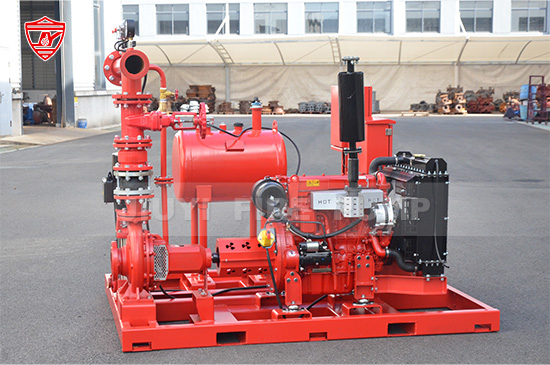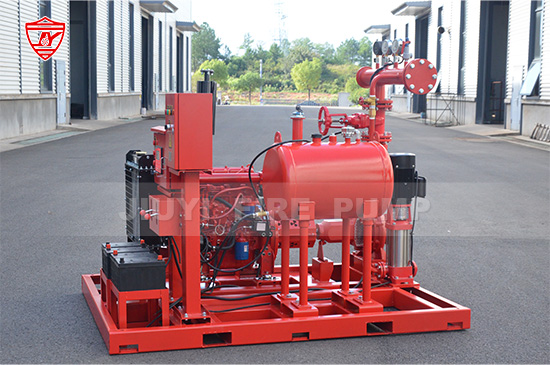Installing fire pumps in regions that experience freezing temperatures presents unique challenges. Extreme cold can cause water in the system to freeze, leading to equipment damage, system failure, or delayed response in an emergency. To ensure continuous operation and compliance with NFPA 20, proper installation methods, environmental control, and preventive maintenance are crucial.
This guide will walk you through best practices for installing fire pumps in cold climates—covering site selection, pump room design, freeze protection, insulation, heating systems, and ongoing maintenance.

Cold environments create several risks for fire pump systems:
Freezing water in suction and discharge lines can damage components or cause system blockage.
Viscosity changes in lubricants can increase mechanical wear.
Electrical issues arise from condensation and moisture accumulation.
Temperature fluctuations can compromise pump alignment and gasket sealing.
Recognizing these potential problems before installation helps you design a system that remains reliable, even in subzero conditions.
When planning a fire pump installation in a cold region, the first consideration is location and enclosure.
NFPA 20 recommends installing fire pumps indoors within a heated, enclosed pump room. This is the most effective way to protect the system from freezing temperatures.
The pump room should maintain a minimum ambient temperature of 4°C (40°F) or above.
Avoid exterior walls or unheated basements where frost can penetrate.
Ensure easy access for inspection, maintenance, and testing year-round.
If an indoor installation is impossible, a prefabricated heated enclosure or pump house is essential.
The enclosure must be insulated and equipped with an automatic heating system.
All doors and joints should be weather-sealed to prevent air leaks.
Include temperature sensors and alarms for early detection of heat loss.
Maintaining a stable temperature is critical to prevent freezing. Multiple heating methods can be used, depending on the installation site.
Electric or gas-fired space heaters are common for pump rooms. Use thermostatically controlled units to maintain consistent temperature and prevent overheating.
Position heaters away from combustible materials.
Choose models designed for industrial environments with automatic shut-off features.
For suction and discharge piping exposed to cold air, electric heat tracing is highly effective. Heating cables run along the pipes to maintain temperature.
Use self-regulating cables for energy efficiency.
Cover all heat-traced pipes with proper insulation.
Regularly test the heat tracing system during seasonal inspections.
For diesel engine fire pumps, maintain the cooling system above freezing point:
Use engine jacket water heaters to prevent coolant from freezing.
Install battery warmers to ensure reliable engine starts.
Monitor temperature through thermostats and alarms.
Proper insulation reduces heat loss and keeps the system safe from freezing.
Use closed-cell foam insulation or fiberglass with vapor barriers. These materials resist moisture absorption and provide durable protection.
Insulate:
Suction and discharge pipes
Valves, strainers, and flanges
Jockey pump lines and small fittings
Backflow preventers and relief valves
Every exposed section is a potential freeze point; thorough coverage is essential.
Apply an aluminum or PVC jacket over insulation to protect against mechanical damage, moisture, and UV exposure.
In cold climates, the water source is one of the most vulnerable components of a fire pump system.
Install suction supply below frost level to prevent freezing.
Use insulated risers and access hatches.
Provide heat tracing for exposed connections.
If using above-ground tanks, ensure the water is kept above 4°C (40°F):
Insulate the tank walls and roof.
Install a tank heating system (electric immersion heaters or circulating water heaters).
Keep circulation active to prevent stratification and ice formation.
The jockey pump plays a vital role in maintaining system pressure and preventing main pump cycling. In cold environments, it requires the same protection as the main fire pump.
Keep jockey pump lines insulated and heated.
Locate pressure switches in the heated area of the pump room.
Check the jockey pump regularly to ensure no freezing or condensation affects its operation.
Proper drainage is essential for systems exposed to cold weather.
Install drain valves at all low points to remove standing water after testing or maintenance.
Use automatic air release valves in vertical sections to prevent trapped air, which can lead to uneven freezing.
Route drains to frost-proof discharge points or heated sumps.
Cold weather can impact electrical reliability through moisture and temperature stress.
Use weatherproof enclosures for control panels.
Keep wiring connections dry with heat-shrink insulation.
Install temperature-compensated battery chargers for diesel fire pump engines.
Conduct seasonal testing to verify all sensors, alarms, and controllers function correctly.
Once the system is installed, careful commissioning and testing ensure reliable performance under cold conditions.
Before starting diesel engines, allow sufficient warm-up time to bring the engine and fluids to operating temperature.
Perform full flow tests to confirm adequate suction supply and discharge performance. Monitor for ice buildup around strainers and discharge lines.
Test all heating components—space heaters, tracing, tank heaters, and thermostats—before the onset of winter.
Preventive maintenance is critical for keeping fire pump systems operational throughout the cold season.
Inspect insulation and heat tracing monthly during winter.
Verify ambient temperature in the pump room remains above the minimum.
Check diesel engine coolant levels and antifreeze concentration.
Run weekly fire pump tests to ensure smooth starting and no signs of freezing.
Record all inspections and maintenance actions as part of NFPA 25 compliance.
Additionally, create a winter readiness checklist for your facility, including emergency contacts, backup heating sources, and spare parts inventory.
Many cold climate fire pump failures result from simple oversights. Avoid these pitfalls:
Installing pumps in unheated or poorly insulated spaces
Neglecting small pipe fittings or drain points
Failing to test heating systems regularly
Ignoring temperature alarms
Using improper insulation materials that absorb moisture
Preventing these mistakes not only protects equipment but also ensures system reliability during life-safety events.

Installing fire pumps in cold climates requires more than just standard procedures—it demands careful attention to temperature control, insulation, and maintenance. A well-designed system ensures your fire protection remains fully functional, even in subzero temperatures.